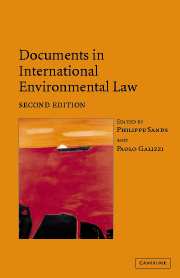Book contents
- Frontmatter
- Contents
- Preface
- PART I General instruments
- PART II Atmosphere
- PART III Oceans: global
- PART IIIB Oceans: regional
- PART IV Freshwater resources
- PART V Biodiversity
- PART VIA Hazardous substances and activities: nuclear
- PART VIB Hazardous substances and activities: pesticides
- PART VIC Hazardous substances and activities: waste
- PART VII Human rights and the environment
- PART VIII War and the environment
- PART IX Trade and the environment
- PART X Environmental impact assessment and access to information
- PART XI Liability for environmental damage and breaches of environmental obligations
- PART XII The Antarctic
- 47 Antarctic Treaty, 1 December 1959
- 47A Protocol on Environmental Protection to the Antarctic Treaty, 4 October 1991
- 48 Convention for the Conservation of Antarctic Seals, 1 June 1972
47A - Protocol on Environmental Protection to the Antarctic Treaty, 4 October 1991
Published online by Cambridge University Press: 05 June 2012
- Frontmatter
- Contents
- Preface
- PART I General instruments
- PART II Atmosphere
- PART III Oceans: global
- PART IIIB Oceans: regional
- PART IV Freshwater resources
- PART V Biodiversity
- PART VIA Hazardous substances and activities: nuclear
- PART VIB Hazardous substances and activities: pesticides
- PART VIC Hazardous substances and activities: waste
- PART VII Human rights and the environment
- PART VIII War and the environment
- PART IX Trade and the environment
- PART X Environmental impact assessment and access to information
- PART XI Liability for environmental damage and breaches of environmental obligations
- PART XII The Antarctic
- 47 Antarctic Treaty, 1 December 1959
- 47A Protocol on Environmental Protection to the Antarctic Treaty, 4 October 1991
- 48 Convention for the Conservation of Antarctic Seals, 1 June 1972
Summary
Editorial note
The object of the Protocol on Environmental Protection to the Antarctic Treaty is to create comprehensive protection of Antarctica's environment and dependent and associated ecosystems (Article 2). To achieve this end, the Protocol requires this protection to be considered ‘fundamental’ in the planning and conduct of all activities in the region (Article 3(1)). The Protocol further requires Parties to plan their activities on the basis of information sufficient to make prior assessments and informed judgements in respect of their impact on the Antarctic environment (Article 3(2)(c)). In particular, the environmental impact assessment procedures set forth in Annex I to the Protocol are to be followed for any activities related to scientific research, tourism or which require advance notice pursuant to the Antarctic Treaty (Article 8). Attached to the Protocol are four other Annexes which create specific environmental obligations: Annex II is on conservation of fauna and flora; Annex III covers waste disposal and management; Annex IV regulates the marine environment; Annex V provides for the creation of specially protected areas. In addition, the Protocol prohibits any activities connected to mineral resources other than scientific research (Article 7) and requires Parties to establish contingency response plans for environmental emergencies (Article 15).
Each Party is required to take appropriate measures to ensure compliance with the Protocol, notify other Parties of the measures it has taken, and notify other Parties of any activity which affects the implementation of the Protocol (Article 13).
- Type
- Chapter
- Information
- Documents in International Environmental Law , pp. 1313 - 1356Publisher: Cambridge University PressPrint publication year: 2004
- 5
- Cited by



